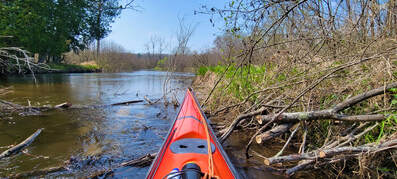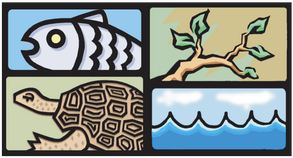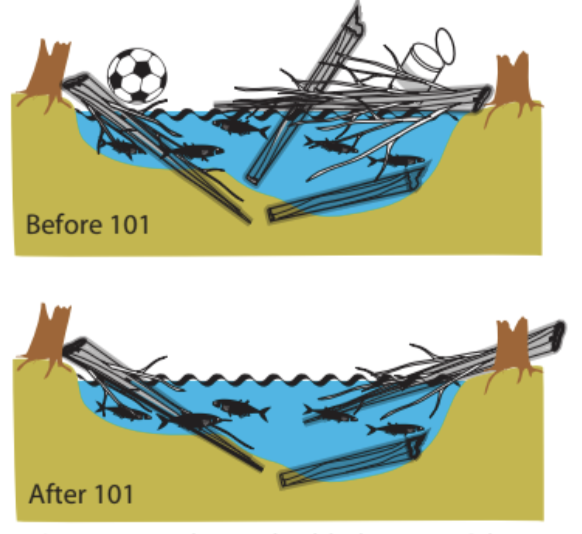Michigan Waterways Stewards
Managing Our Waterways
Properly managed logjams help reduce erosion, provide habitat for fish and wildlife, and are an important part of a river system's natural processes.
Woody Debris Management (WDM) is the process of determining whether to move, remove or add woody debris in a river and how best to do that work. The Clean and Open Method of Woody Debris Management has been specifically developed to give guidance on how to manage logjams, preserving the benefits they provide while minimizing the problems they can create.
The following method can be used at individual sites effectively and is designed to be part of a larger riparian corridor management plan.
Clean and Open Method
|
1. PLAN - Address public health, legal access, safety concerns, define point of access to river, determine depth of water, flow and emergency plans.
2. CLEAN - Remove urban rubbish (man-made materials) and dispose properly. 3. OPEN - Move or cut loose, floating debris to allow a passage for flow. Use a handsaw or chain saw to make the opening wide enough to allow flow through log jam. 4. Place excess woody debris along streambanks and in the adjacent riparian corridor to create habitat. 5. Leave woody debris that is embedded in the stream's banks or bottom undisturbed. 6. Minimize impact to the riparian corridor at work site. |
No Permit Required.
- Hand removal of an obstruction (such as log jams or beaver dams) that does not alter the soil, sediment, bed, or banks of a wetland or stream.
- Typically, this would follow the “Clean and Open Method” where the woody material is cut and removed within the main channel area to allow the natural flow of water, without removing woody or soil material that is in the bed or banks.
Benefits.

1. Requires no Michigan Department of Environmental Quality Inland Lakes and Streams Permit.
2. Creates, preserves and enhances fish, aquatic invertebrate and wildlife habitat structure.
3. Reduces localized flooding and erosion while maintaining flow reduction and sediment deposition benefits.
4. Increases and/or maintains the river's aesthetic value.
5. Meets the habitat creation, riparian vegetation preservation and erosive flow reduction requirements of the Michigan General Stormwater permit.
6. Saves money by eliminating the need to use heavy machinery and extensive restorative work.
7. Involves multiple volunteers and activities can be done by hand.
2. Creates, preserves and enhances fish, aquatic invertebrate and wildlife habitat structure.
3. Reduces localized flooding and erosion while maintaining flow reduction and sediment deposition benefits.
4. Increases and/or maintains the river's aesthetic value.
5. Meets the habitat creation, riparian vegetation preservation and erosive flow reduction requirements of the Michigan General Stormwater permit.
6. Saves money by eliminating the need to use heavy machinery and extensive restorative work.
7. Involves multiple volunteers and activities can be done by hand.
Best Management Practices (Dos)
Vertical Divider
|
Best Management Practices (Dont's)
|
Volunteer ActivitiesSome equipment you might need for repositioning, modifying or removing large woody debris are:
1. Hand saws. 2. Stout rope. 3. Come-alongs, block & tackle. 4. Chain saws (to be operated by trained users only). |
Materials NeededSome activities for volunteers include:
1. Trash removal teams for man-made materials in stream, on floodplain or riparian corridor. 2. Logjam opening team. 3. Equipment support team providing equipment to workers in stream. 4. Rope teams to move or remove loose, floating woody debris. 5. Planting teams for native trees, shrubs and grasses in riparian buffer zone. |
WOODY DEBRIS MANAGEMENT
Who can do this work?
Anyone (including public entities and private citizens) can implement WDM 101 techniques in a watercourse if they follow the basic guidelines outlined in this document. For safety reasons, one person efforts are discouraged. Two people can accomplish useful improvements safely. We recommend partnership and teamwork.
Where can this work be done?
WDM 101 can be implemented in any river system where logjams are present. Some woody debris buildups will not be causing any negative impacts and therefore are unnecessary to work on.
However, some may be causing 'excessive' flooding (flooding that is directly damaging property), extreme bank erosion and may be trapping urban rubbish. These types of logjams could benefit from CLEAN and OPEN work. Some jams may only be trapping rubbish but not causing flooding or erosion. These logjams can benefit from the CLEAN process but really do not require any OPEN work. There are some logjams that may be causing problems that can directly impact human safety or causing real property damage (an example is an eroding building foundation.) In this case, the WDM 101 method may not apply and other WDM methods could be considered.
How is this work done?
Determine what you want to accomplish. If the goals of the activity are to remove the man made trash and improve the flow through an existing logjam or to alleviate localized flooding and erosion, then WDM 101 is the proper method.
Know your work site.
Determine how safe the watercourse is to work in. Define a point to get in and out of the river. Locate where you will place excess woody debris along the streambank and in the riparian corridor.
Develop a work plan that is focused on safety and teamwork.
If there are questions, ask for assistance. Make sure that the work team understands scope of work and assignments. One common issue during projects is that, due to enthusiasm of the work crews, the logjam is completely removed through the course of the work. Provide necessary tools and materials and remember to take your time and works safely.
Remember, if you only Clean a portion and Open a portion, you have done some useful work. Every effort helps and the accumulative effects of this work over time will make a difference to reduce workload and to accomplish more complete projects.
Anyone (including public entities and private citizens) can implement WDM 101 techniques in a watercourse if they follow the basic guidelines outlined in this document. For safety reasons, one person efforts are discouraged. Two people can accomplish useful improvements safely. We recommend partnership and teamwork.
Where can this work be done?
WDM 101 can be implemented in any river system where logjams are present. Some woody debris buildups will not be causing any negative impacts and therefore are unnecessary to work on.
However, some may be causing 'excessive' flooding (flooding that is directly damaging property), extreme bank erosion and may be trapping urban rubbish. These types of logjams could benefit from CLEAN and OPEN work. Some jams may only be trapping rubbish but not causing flooding or erosion. These logjams can benefit from the CLEAN process but really do not require any OPEN work. There are some logjams that may be causing problems that can directly impact human safety or causing real property damage (an example is an eroding building foundation.) In this case, the WDM 101 method may not apply and other WDM methods could be considered.
How is this work done?
Determine what you want to accomplish. If the goals of the activity are to remove the man made trash and improve the flow through an existing logjam or to alleviate localized flooding and erosion, then WDM 101 is the proper method.
Know your work site.
Determine how safe the watercourse is to work in. Define a point to get in and out of the river. Locate where you will place excess woody debris along the streambank and in the riparian corridor.
Develop a work plan that is focused on safety and teamwork.
If there are questions, ask for assistance. Make sure that the work team understands scope of work and assignments. One common issue during projects is that, due to enthusiasm of the work crews, the logjam is completely removed through the course of the work. Provide necessary tools and materials and remember to take your time and works safely.
Remember, if you only Clean a portion and Open a portion, you have done some useful work. Every effort helps and the accumulative effects of this work over time will make a difference to reduce workload and to accomplish more complete projects.
|
This document, "Woody Debris Management," was recommended by Cliff Walls, Environmental Specialist, City of East Lansing. It was funded, in part, by the Rouge River National Wet Weather Demonstration Project, EPA Grant #XP9955743, 01 - 09 and C995743-01. To read the document in its entirety, click on the image below.
|
The same "Woody Debris Management" practices was referred to and presented by Anne Garwood, Michigan Department of Environment, Great Lakes and Energy, December 2022.
| ||||||||||||
|
Michigan Waterways Stewards Stewardship • Education • Advocacy
We are a federally tax-exempt Michigan nonprofit corporation. EIN: 92-1772858
Copyright © 2022 Site created by i3 Marketing, LLC.
|



